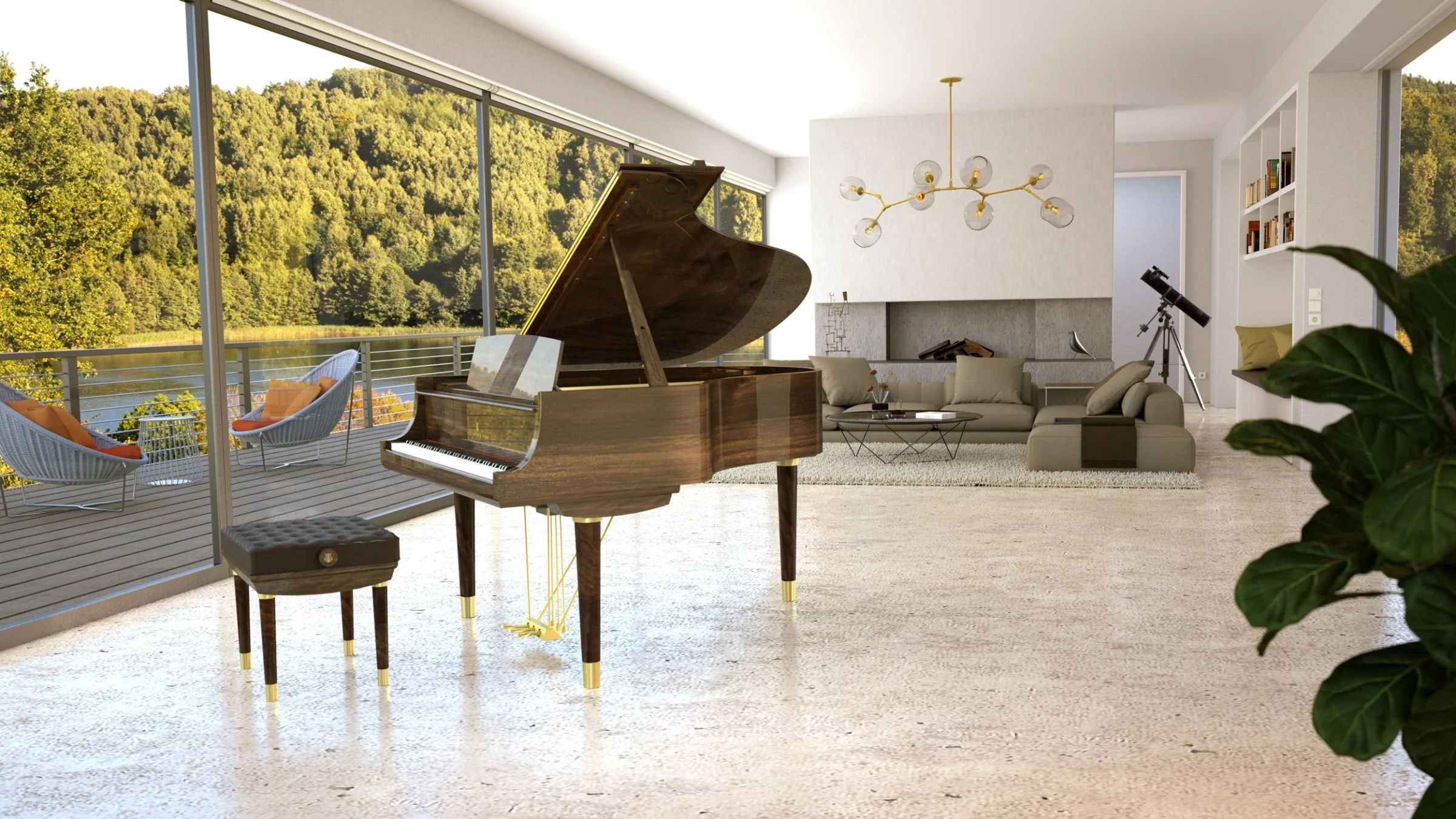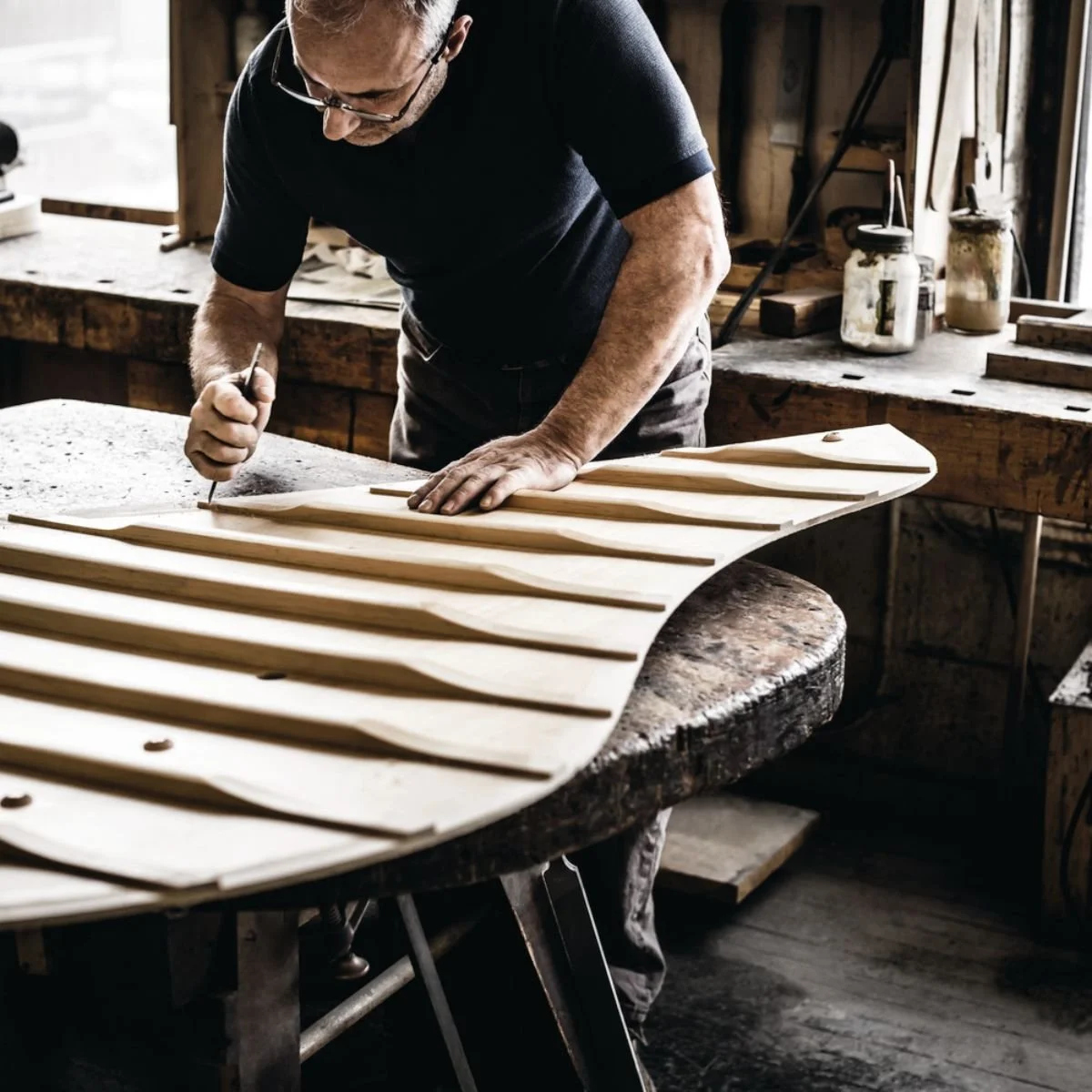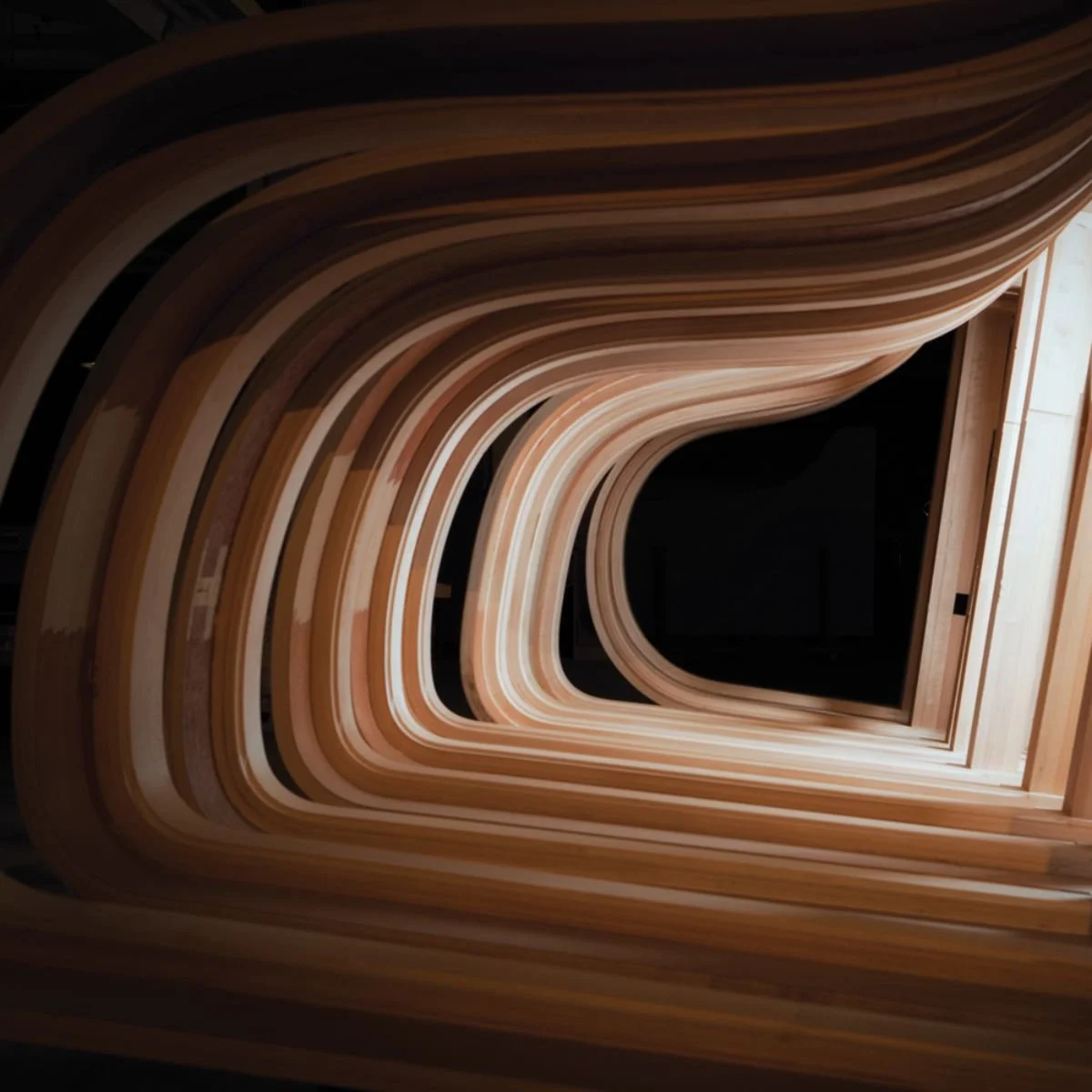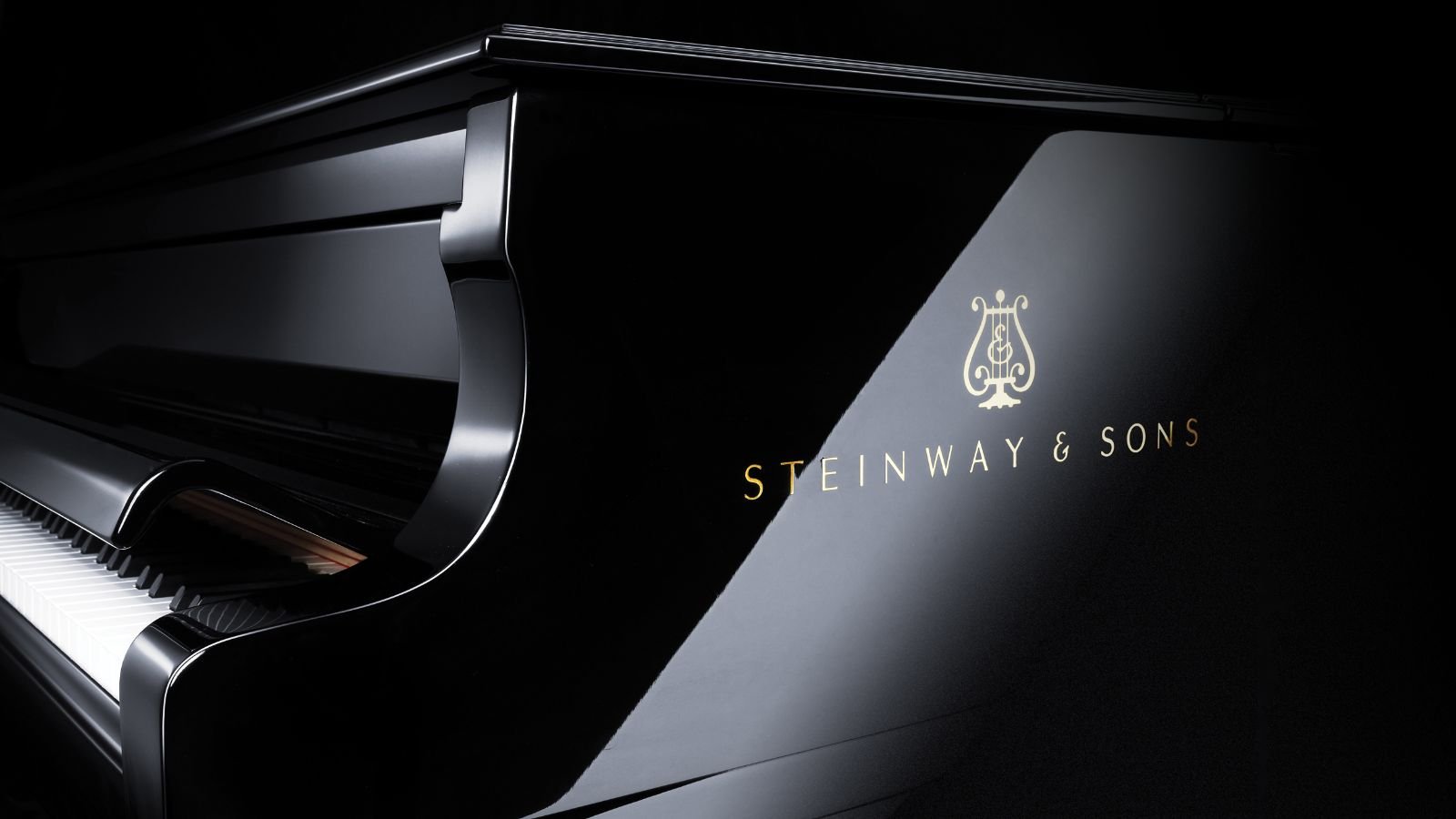Today’s Steinway, is the BEST Steinway. Learn Why.
The Steinway Diaphragmatic Soundboard is based on an innovative patent to achieve optimum performance in dynamic range and maximum sustain. Under this patent, the soundboard is gradually tapered from the centre to the edge, permitting freedom of movement and creating a sound of unparalleled richness, sonority, and sustain.
Today, the Steinway & Sons soundboard spruce is sourced entirely from one singular island in Alaska, the only location that meets their stringent specifications. This unique micro-climate provides spruce with the highest quality grain density, direction and colour thus improving the transmission of tonal string vibrations. In recent years, specifications have been tightened on grain angularity and grain direction with no more than +/- 15 degrees off of 90-degree vertical grain being allowed, making for a superiorly uniform soundboard.
Steinway also recently implemented state-of-the-art machinery and conditioning rooms to more precisely meet the specifications of soundboard design. Beginning in 2021, a new custom-five-axis piano-rim machining centre will achieve an unparalleled fit between the soundboard and the rim, ensuring pristine resonance, tonal colour and purity of sound.
Hand fitting the Steinway Soundboard ribs
Within the last decade, Steinway & Sons has built and installed more than 15 Programmable Logic Controlled Conditioning Rooms, enabling us to manufacture parts that are more exacting in dimension and can better withstand changes in temperature and humidity of the environment where a piano resides.
A computer-monitored measuring machine was developed and installed by our engineers that checks our action parts daily so that they are measured to an exactness of 1/32,000th of an inch, a level never before attained. This proprietary measurement tool takes multi-dimensional photographs to ensure that each part meets our vastly improved specifications.
With more exacting and precise parts, they have been able to significantly improve the up-weight of our piano keys so that our actions are more responsive than ever before — an improvement so vast, we could never have imagined achieving such responsive action, repeatable so quickly, a mere 10 years ago.
They have also introduced new materials throughout our action that reduce friction and resistance. These improved materials reduce action noise and wear-and-tear, so not only do our actions respond better and produce better tone, they also last longer and require less service.
The Steinway Action assembly
Thanks to Steinway’s advancements and innovations in technology and process, the improved cast-iron plate is one of the reasons why the pianos they build today sound and play better — and last longer — than those built just a decade ago.
Steinway & Sons now owns and operates its own foundry solely to produce the elemental, integral cast-iron plate to exacting specifications. The foundry forges the bell-quality plate with a new No-Bake Process implemented just five years ago, which permits a single-use high-strength mold that creates more precise and consistent casting.
They have added a revolutionary thermal reclaiming process. Additionally, new machinery enables greater precision for the milling of the plate (up to 0.008 of an inch).
Finally, Steinway’s metallurgy lab has been modernized to further optimize the hardness and strength of the casting, all but eliminating potential deformations or cracks that could occur once the plate is strung.
Custom fitting a Steinway Plate to a piano.
Steinway & Sons’ piano hammer felt is made of premium Merino wool from Australia and Africa. In the past ten years, they have greatly improved the wool’s quality: while they previously used a blend of wool fibers of varying lengths, they now use 100% long-length, thus improving the interlocking nature of the fibers, and giving the felt increased overall strength. They have also improved the carding and pressing processes of the raw wool, achieving a much more stable and consistent hammer felt.
In recent years, they have improved on the design of the Steinway hammer to incorporate a denser and purer hammer felt. The benefits of this new design permit us to achieve optimal hammer firmness without excessive use of chemical hardeners. This naturally harder hammer felt produces an enhanced “singing” tone in the piano by permitting the long-length fibers to remain undisturbed, all while preserving the felt’s natural barbs and lanolin.
Extensive research and development of the hammer-pressing process has allowed for a more exact hammer shape. A computer-controlled boring machine has been integrated into production to ensure increased accuracy of hammer angles relative to the strings.
Steinway Hammers
A Steinway carries up to 46,000 pounds of tension from its strings. The piano rim supports this tension while simultaneously supporting and enhancing the acoustical properties of the soundboard. Steinway’s patented one-piece continuous bent rim generates its strength by bending single laminations of premium, straight-grained rock maple in an unbroken curve to form the rim of the piano.
The process of bending a Steinway rim completely by hand has taken place in the factory for over 140 years, and recent developments in that process have produced a vastly improved piano rim. Within the last ten years, they have made improvements to the rim presses and the conditioning process for these hand-bent rims: new reinforced clamping cauls improve the curvature of the rim; new pneumatic wrenches guarantee the proper amount of glue between laminations; and new stabilizers are inserted after the rim has been bent to ensure the rims maintain their optimal shape. Additionally, rims are now placed in new Programmable Logic Controlled Conditioning Rooms that ensure impeccable curing of the wood and glue.
Today’s Steinway rim has improved stability, durability, and strength — which together create the distinctive “Steinway Sound.” Never before has the rim emboldened their unique diaphragmatic soundboard to vibrate so freely and generate such a magnificent, golden tone.
Rims in the Steinway Conditioning Room
Within the last five years, Steinway & Sons has developed a unique finish and utilized the best Italian furniture polishing equipment to create the new Steinway DiamondGloss™ finish. Our unique formula provides a depth of color and sheen unmatched in the world of fine furniture manufacturing. The custom hand-applied materials and computer-controlled polishing technology produce the flattest, most even and highest sheen finish.
The computer-controlled polishing equipment precisely monitors the amount of material used, as well as the amount of pressure applied during the polishing process. The custom application of this high-quality finish is three times thicker than a satin lacquer finish — and is more durable and resistant to scratches and fading.








